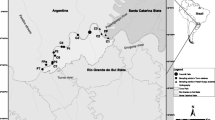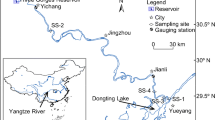Abstract
We investigated the influence of human activities on the spawning migration of the mud loach, Misgurnus anguillicaudatus. Mud loaches migrate from rivers to paddy fields for spawning. In this study, the number of adult loaches in paddy fields showed a peak in late May and rapidly decreased in July. In early July, water is discharged from paddy fields in order to allow the fields to dry for a few weeks, and water is again supplied later. The spawning season of the loaches probably spans from mid May to August; this was concluded by observing physiological indicators such as the gonad somatic index, oocyte maturity and serum levels of testosterone, estradiol-17β and 17α, 20β-dihydroxy-4-pregnen-3-one. When the loaches mature, they migrated to paddy fields if they could swim upward through the drainage ditches. However, the drainage ditches of modern paddy fields were reconstructed to deepen the water levels. The artificial drought of the rice culture management led to a discharge of water and loaches from the paddy fields during their spawning season. These results indicate that modern rice cultivation causes obstruction of the migration route and loss of spawning grounds; consequently, loaches use limited space and period of the paddy field for their spawning.








Similar content being viewed by others
References
Anguis V, Canavate JP (2005) Spawning of captive Senegal sole (Solea senegalensis) under a naturally fluctuating temperature regime. Aquaculture 243:133–145
Arnekleiv JV, Kraabol M (1996) Migratory behaviour of adult fast-growing brown trout (Salmo trutta, L.) in relation to water flow in a regulated Norwegian river. Regul Rivers Res Manage 12:39–49
Beam JH (1983) The effect of annual water level management on population trends of white crappie in Elk City reservoir, Kansas. North Am J Fish Manage 3:34–40
Farrell JM (2001) Reproductive success of sympatric northern pike and muskellunge in an upper St. Lawrence River Bay. Trans Am Fish Soc 130:796–808
Fujioka M, Lane SJ (1997) The impact of changing irrigation practices in rice fields on frog populations of the Kanto Plain, central Japan. Ecol Res 12:101–108
Gehrke PC, Gilligan DM, Barwick M (2001) Fish communities and migration in the Shoalhaven River—before construction of a fishway. NSW Fish. Final Report Series 26, 140 pp
Grift RE, Buijse AD, Klein Breteler JGP, van Densen WLT, Machiels MAM, Backx JJGM (2001) Migration of bream between the main channel and floodplain lakes along the lower River Rhine during the connection phase. J Fish Biol 59:1033–1055
Hasegawa S, Tabuchi T (1995) Well facilitated paddy fields in Japan. In: Tabuchi T, Hasegawa S (ed) Paddy fields in the world. The Japanese Society of Irrigation, Drainage and Reclamation Engineering (JSIDRE), Tokyo, 353 pp
Hilder ML, Pankhurst NW (2003) Evidence that temperature change cues reproductive development in the spiny damselfish, Acanthochromis polyacanthus. Environ Biol Fish 66:187–196
Inoue H, Tokunaga K (1995) Soil and water management. In: Tabuchi T, Hasegawa S (eds) Paddy fields in the world. The Japanese Society of Irrigation, Drainage and Reclamation Engineering (JSIDRE), Tokyo, 353 pp
Katano O, Hosoya K, Iguchi K, Yamaguchi M, Aonuma Y, Kitano S (2003) Species diversity and abundance of freshwater fishes in irrigation ditches around rice fields. Environ Biol Fish 66:107–121
Kobayashi M, Aida K, Hanyu I (1986) Annual changes in plasma levels of gonadotropin and steroid hormones in goldfish. Bull Jpn Soc Sci Fish 52:1153–1158
Kubota Z, Kuga M, Okamasa T, Maeda T (1965) Studies on culturing of Japanese loach, Misgurnus anguillicaudatus (Cantor)—VII. Yield of the loach fry cultured in ponds, with estimation of the suitable stage to transferring, suitable ingredient of artificial food and the promotive effect of mud covering the bottom (in Japanese with English abstract). J Shimonoseki Univ Fish 14:59–73
Kwak TJ (1988) Lateral movement and use of floodplain habitat by fishes of the Kankakee River, Illinois. Am Mid Nat 120:241–249
Matsuyama M, Adachi S, Nagahama Y, Kitajima C, Matsuura S (1991) Annual reproductive cycle of the captive female Japanese sardine Sardinops melanostictus: relationship to ovarian development and serum levels of gonadal steroid hormones. Mar Biol 108:21–29
Mizutani S (2000) Migration of the loach to the paddy field. Rural Environ 16:70–76
Nagahama Y (1997) 17,20-Dihydroxy-4-pregnen-3-one, a maturation-inducing hormone in fish oocytes: mechanisms of synthesis and action. Steroids 62:190–196
Naruse M, Oishi T (1996) Annual and daily activity rhythms of loaches in an irrigation creek and ditches around paddy fields. Environ Biol Fish 47:93–99
Poulsen A, Poeu O, Viravong S, Suntornratana U, Tung NT (2002) Deep pools as dry season fish habitats in the Mekong River basin. MRC Tech Pap 4:24
Razani H, Hanyu I, Aida K (1988) Environmental influences on ovarian activity and related hormones in yearling goldfish. Bull Jpn Soc Sci Fish 54:1505–1511
Saitoh K, Katano O, Koizumi A (1988) Movement and spawning of several freshwater fishes in temporary waters around paddy fields (in Japanese with English abstract). Jpn J Ecol 38:35–47
Sargent JC, Galat DL (2002) Fish mortality and physicochemistry in a managed floodplain wetland. Wetlands Ecol Manage 10:115–121
Sommer TR, Conrad L, O’Leary G, Feyrer F, Harrell WC (2002) Spawning and rearing of splittail in a model floodplain wetland. Trans Am Fish Soc 131:966–974
Suzuki R (1976) Number of ovarian eggs and spawned eggs and their size composition in the loach, Cyprinid fish. Bull Jpn Soc Sci Fish 42:961–967
Suzuki R, Yamaguchi M (1977) Effect of temperature on maturation of a Cyprinid loach. Bull Jpn Soc Sci Fish 43:367–373
Suzuki M, Mizutani S, Goto A (2001) Trial manufactures and experiments of small-scale fishways to ensure both upward and downward migration of freshwater fishes in the aquatic area with paddy fields (in Japanese with English abstract). Ecol Civil Eng 4:163–177
Svendsen JC, Koed A, Aarestrup K (2004) Factors influencing the spawning migration of female anadromous brown trout. J Fish Biol 64:528–540
Tanaka M (1999) Influence of different aquatic habitats on distribution and population density of Misgurnus anguillicaudatus in paddy fields (in Japanese with English abstract). Jpn J Ichthyol 46:75–81
Teranishi T, Hara A, Takahashi H (1981) Changes of serum vitellogenin levels during the course of annual reproductive cycle of the loach Misgurnus anguilliacaudatus (in Japanese with English abstract). Bull Fac Fish Hokkaido Univ 32:281–292
Turner TF, Trexler JC, Miller GL, Toyer KE (1994) Temporal and spatial dynamics of larval and juvenile fish abundance in a temperate floodplain river. Copeia 1994:174–183
Yamada H, Satoh R, Ogoh M, Takaji K, Fujimoto Y, Hakuba T, Chiba H, Kambegawa A, Iwata M (2002) Circadian changes in serum concentrations of steroids in Japanese char Salvelinus leucomaenis at the stage of final maturation. Zool Sci 19:891–898
Yamamoto K, Yamazaki F (1961) Rhythm of development in the oocyte of the gold-fish, Carassius auratus. Bull Fac Fish Hokkaido Univ 12:246–253
Yamauchi K, Ban M, Kasahara N, Izumi T, Kojima H, Harako T (1985) Physiological and behavioral changes occurring during smoltification in the masu salmon, Oncorhynchus masou. Aquaculture 45:227–235
Yuma M, Hosoya K, Nagata Y (1998) Distribution of the freshwater fishes of Japan: a historical overview. Environ Biol Fish 52:97–124
Acknowledgements
We thank people in the Tsuchi-buchi area in Tono City. We thank also for the assistance of K. Tokunaga, S. Yamamoto, K. Ishihara and T. Yakushiji. This study was supported by the Iwate prefecture and the Kyouwa Concrete Industry Co. Ltd.
Author information
Authors and Affiliations
Corresponding author
Rights and permissions
About this article
Cite this article
Fujimoto, Y., Ouchi, Y., Hakuba, T. et al. Influence of modern irrigation, drainage system and water management on spawning migration of mud loach, Misgurnus anguillicaudatus C.. Environ Biol Fish 81, 185–194 (2008). https://doi.org/10.1007/s10641-007-9188-7
Received:
Accepted:
Published:
Issue Date:
DOI: https://doi.org/10.1007/s10641-007-9188-7




